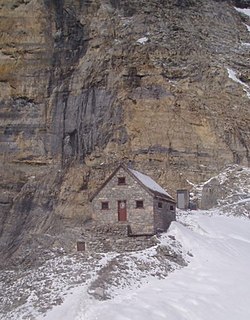| Abbot Pass hut | |
|---|---|
 | |
 | |
| General information | |
| Status | Closed |
| Type | alpine hut |
| Architectural style | Stone Cabin |
| Location | Abbot Pass |
| Country | |
| Coordinates | 51°21′50.598″N 116°17′24.7488″W / 51.36405500°N 116.290208000°W |
| Opened | 1922 |
| Closed | 2018 |
| Demolished | 2022 |
| Owner | Alpine Club of Canada |
| Technical details | |
| Material | Stone |
| Design and construction | |
| Architect(s) | Canadian Pacific Railway |
| Website | |
| https://www.alpineclubofcanada.ca/web/ACCMember/Huts/Abbot_Pass_Hut.aspx | |
The Abbot Pass hut was an alpine hut located at an altitude of 2,925 metres (9,596 ft) in Abbot Pass in the Rocky Mountains in Alberta, Canada. It was nestled between Mount Victoria and Mount Lefroy, straddling the Great Divide,[1] which, in this region, defines the boundary between Banff National Park in Alberta and Yoho National Park in British Columbia. While close to the border, the hut lay entirely in Banff National Park, and was the second-highest permanently habitable structure in Canada (after the Neil Colgan Hut). The hut was maintained by the Alpine Club of Canada.[2][3][4]
Abbot Pass hut was declared a National Heritage site in 1992. It was closed in the summer of 2018 pending a geotechnical evaluation of the slope which underlay the structure, after a hiker noticed erosion on its eastern side, due to melting glacier ice.[5] The COVID-19 pandemic delayed repair work; by the time work was able to begin again, the hut was deemed irreparable. In June 2022, it was demolished.[3][6][4][7][8]
- ^ Cite error: The named reference
accwas invoked but never defined (see the help page). - ^ Haberl, Keith (1997). Alpine Huts: A guide to the facilities of the Alpine Club of Canada. Alpine Club of Canada. pp. 61–68. ISBN 0-920330-32-0.
- ^ a b Moore, Sarah (25 February 2022). "Climate change forces Parks Canada to dismantle, remove historic mountain hut". CBC News. Retrieved 29 March 2022.
- ^ a b Marty, Sid (28 March 2022). "Requiem for a Mountain Sanctuary". The Tyee. Retrieved 29 March 2022.
- ^ Fletcher, Robson (August 11, 2018). "Historic Abbot Pass Hut on Alberta-B.C. border closed due to slope erosion". Canadian Broadcasting Corporation. CBC News. Retrieved 11 August 2018.
- ^ Weisbrod, Kaitlyn (12 March 2022). "Heat Hurts Historic Hut". Inside Climate News.
- ^ Shaun King (2022-06-22). Climbing Conditions, Mt. Victoria & Lake Louise Group (Report). ACMG.
- ^ "Century-old stone hut built by Swiss guides in Rockies dismantled due to erosion". CBC News. The Canadian Press. 2022-07-13.